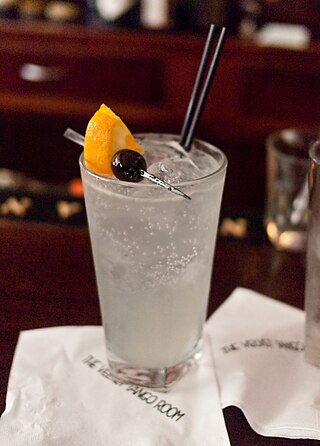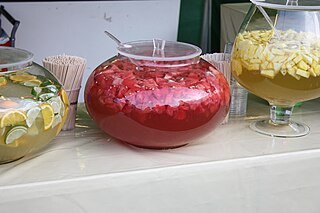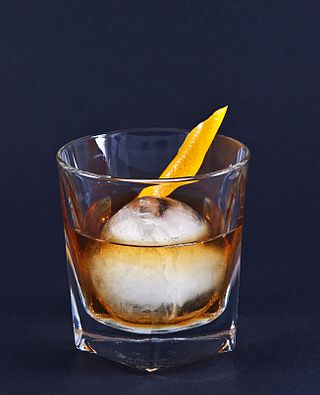
Mojito is a traditional Cuban punch. The cocktail often consists of five ingredients: white rum, sugar, lime juice, soda water, and mint. Its combination of sweetness, citrus, and herbaceous mint flavors is intended to complement the rum, and has made the mojito a popular summer drink.

The Tom Collins is a Collins cocktail made from gin, lemon juice, sugar, and carbonated water. First memorialized in writing in 1876 by Jerry Thomas, "the father of American mixology", this "gin and sparkling lemonade" drink is typically served in a Collins glass over ice. A non-alcoholic "Collins mix" mixer is produced, enjoyed by some as a soft drink.

A margarita is a cocktail consisting of tequila, triple sec, and lime juice. Some margarita recipes include simple syrup as well and are often served with salt on the rim of the glass. Margaritas can be served either shaken with ice, without ice, or blended with ice. Most bars serve margaritas in a stepped-diameter variant of a cocktail glass or champagne coupe called a margarita glass. The margarita is one of the world's most popular cocktails and the most popular tequila-based cocktail.

French 75 is a cocktail made from gin, champagne, lemon juice, and sugar. It is also called a 75 Cocktail, or in French simply a Soixante Quinze.

The daiquiri is a cocktail whose main ingredients are rum, citrus juice, and sugar or other sweetener.

The Singapore sling is a gin-based sling cocktail from Singapore. This long drink was developed sometime before 1915 by Ngiam Tong Boon, a bartender at the Long Bar in Raffles Hotel, Singapore. It was initially called the gin sling.

The term punch refers to a wide assortment of drinks, both non-alcoholic and alcoholic, generally containing fruits or fruit juice. The drink was introduced from the Indian subcontinent to England by employees of the East India Company in the late 17th century. Punch is usually served at parties in large, wide bowls, known as punch bowls.

A sour is a traditional family of mixed drinks. Sours belong to one of the old families of original cocktails and are described by Jerry Thomas in his 1862 book How to Mix Drinks.

Buck's fizz is an alcoholic cocktail made of about two parts sparkling wine, typically champagne, to one part orange juice. It is essentially the same as the mimosa; the International Bartenders Association considers the two drinks synonymous. Other sparkling wines may also be used.
A Scorpion Bowl is a communally shared alcoholic tiki drink served in a large ceramic bowl traditionally decorated with wahine or hula-girl island scenes and meant to be drunk through long straws. Bowl shapes and decorations can vary considerably. Starting off as a single-serve drink known as the Scorpion cocktail, its immense popularity as a bowl drink in tiki culture is attributed to Trader Vic.

Cocktail garnishes are decorative ornaments that add character or style to a mixed drink, most notably to cocktails.
Drink mixers are the non-alcoholic ingredients in mixed drinks and cocktails. Mixers dilute the drink, lowering the alcohol by volume in the drink. They change, enhance, or add new flavors to a drink. They may make the drink sweeter, more sour, or more savory. Some mixers change the texture or consistency of the drink, making it thicker or more watery. Drink mixers may also be used strictly for decorative purposes by changing the color or appearance of the drink. They also simply increase the volume of a drink, to make it last longer.

The Pimm's cup is a cocktail that is popular in England, in the United Kingdom. It is one of numerous fruit cups, a type of cocktail with gin, a soft drink, and fruit. Its primary spirit is Pimm's No. 1 Cup, a gin-based beverage flavored with fruits and spices invented around 1823 as a health drink.

The pink lady is a classic gin-based cocktail with a long history. Its pink color comes from grenadine.

The vampiro is a cocktail that includes fruit juice, spices, fruit soda, fresh lime juice, and tequila. The vampiro has a fruity, lightly carbonated, and spicy taste.

The doctor cocktail is a pre-prohibition era cocktail that traces in drink guides to as far back as 1917, when it appeared in Hugo R. Ensslin's Recipes for Mixed Drinks. As originally described the cocktail called simply for Swedish Punsch mixed with lime juice.

A whiskey cocktail is a cocktail that includes whiskey. Although whiskey is often served neat or on the rocks, it is used in many classic cocktails such as the Old Fashioned, Manhattan, and Julep. Some specifically call for Scotch whisky or bourbon whiskey.




















